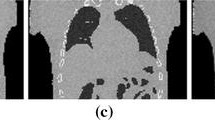Abstract
Purpose: Attenuation correction with an X-ray CT image is a new method to correct attenuation on SPECT imaging, but the effect of the registration errors between CT and SPECT images is unclear. In this study, we investigated the effects of the registration errors on myocardial SPECT, analyzing data from a phantom and a human volunteer.Methods: Registerion (fusion) of the X-ray CT and SPECT images was done with standard packaged software in three dimensional fashion, by using linked transaxial, coronal and sagittal images. In the phantom study, an X-ray CT image was shifted 1 to 3 pixels on thex, y andz axes, and rotated 6 degrees clockwise. Attenuation correction maps generated from each misaligned X-ray CT image were used to reconstruct misaligned SPECT images of the phantom filled with201Tl. In a human volunteer, X-ray CT was acquired in different conditions (during inspiration vs. expiration). CT values were transferred to an attenuation constant by using straight lines; an attenuation constant of 0/cm in the air (CT value=−1,000 HU) and that of 0.150/cm in water (CT value=0 HU). For comparison, attenuation correction with transmission CT (TCT) data and an external γ-ray source (99mTc) was also applied to reconstruct SPECT images.Results: Simulated breast attenuation with a breast attachment, and inferior wall attenuation were properly corrected by means of the attenuation correction map generated from X-ray CT. As pixel shift increased, deviation of the SPECT images increased in misaligned images in the phantom study. In the human study, SPECT images were affected by the scan conditions of the X-ray CT.Conclusion: Attenuation correction of myocardial SPECT with an X-ray CT image is a simple and potentially beneficial method for clinical use, but accurate registration of the X-ray CT to SPECT image is essential for satisfactory attenuation correction.
Similar content being viewed by others
References
Murase K, Tanada S, Inoue T, Sugawara Y, Hamamoto K. Improvement of brain single photon emission tomography (SPET) using transmission data acquisition in a four-head SPET scanner.Eur J Nucl Med 1993; 20: 32–38.
Almeida P, Bendriem B, Dreuille O, Peltier A, Perrot C, Brulon V. Dosimetry of transmission measurements in nuclear medicine: a study using anthromorphic phantoms and thermoluminescent dosimeters.Eur J Nucl Med 1998; 25: 1435–1441.
Bocher M, Balan A, Krausz Y, Shrem Y, Lonn A, Wilk M, et al. Gamma camera-mounted anatomical X-ray tomography: technology, system characteristics and first images.Eur J Nucl Med 2000; 27: 619–627.
Patton JA, Delbeke D, Sandler MP. Image fusion using an integrated, dual-head coincidence camera with X-ray tube-based attenuation maps.J Nucl Med 2000; 41: 1364–1368.
Kalki K, Blankespoor SC, Brown JK, Hasegawa BH, Dae MW, Shin M, et al. Myocardial perfusion imaging with a combined x-ray CT and SPECT system.J Nucl Med 1997; 38: 1535–1540.
Takahashi Y, Murase K, Higashino H, Sogabe I, Sakamoto K. Receiver operating characteristic (ROC) analysis of image reconstructed with iterative expectation maximization algorithms.Ann Nucl Med 2001; 15: 521–525.
Motomura N, Ichihara T, Satou T, Kinda A, Kitano T, Kubo H. Examination of the SPECT attenuation correction using the X-ray CT image [abstract].KAKU IGAKU (Jpn J Nucl Med) 1999; 36: 617.
Ardekani BA, Braun M, Hutton BF, Kanno I, Iida H. A Fully Automatic Multimodality Image Registration Algorithm.J Comput Assist Tomogr 1995; 19: 615–623.
Fleming JS. A technique for using CT images in attenuation correction and quantification in SPECT.Nucl Med Commun 1989; 10: 83–97.
Kamel E, Hany TF, Burger C, Treyer V, Lonn AHR, von Schulthess GK. CT vs68Ge attenuation correction in a combined PET/CT system: evaluation of the effect of lowering the CT tube current.Eur J Nucl Med 2002; 29: 346–350.
Murase K, Tanada S, Inoue T, Sugawara Y, Hamamoto K. Effect of misalignment between transmission and emission scans on SPECT images.J Nucl Med Technol 1993; 21: 152–156.
Stone CD, McCormick JW, Gilland DR, Greer KL, Coleman RE, Jaszczak RJ. Effect of registration errors between transmission and emission scans on a SPECT system using sequential scanning.J Nucl Med 1998; 39: 365–373.
Koole M, D'Asseler Y, Van LK, Van de Walle R, Van de Wiele C, Lemahieu I. MRI-SPET and SPET-SPET brain co-registration: Evaluation of the performance of eight different algorithms.Nucl Med Commun 1999; 20: 659–669.
Suga K, Matsunaga N, Kawakami Y, Furukawa M. Phantom study of fusion image of CT and SPECT with body-contour generated from Compton scatter sources.Ann Nucl Med 2000; 14: 271–277.
Author information
Authors and Affiliations
Corresponding author
Rights and permissions
About this article
Cite this article
Takahashi, Y., Murase, K., Higashino, H. et al. Attenuation correction of myocardial SPECT images with X-ray CT: Effects of registration errors between X-ray CT and SPECT. Ann Nucl Med 16, 431–435 (2002). https://doi.org/10.1007/BF02990083
Received:
Accepted:
Issue Date:
DOI: https://doi.org/10.1007/BF02990083




